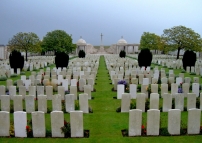| First Name: | Herbert Charles | Last Name: | WILLINGTON | |
|---|---|---|---|---|
| Date of Death: | 26/09/1915 | Lived/Born In: | Kilburn | |
| Rank: | Lance Corporal | Unit: | Worcestershire2 | |
| Memorial Site: | Loos Memorial, France | |||
Current Information:Age-28 35 Cambridge Avenue, Kilburn The Battle of Loos This battle, fought by the British Army from 25th September, 1915 through to 13th October, was conducted along a six-and-a-half-mile front running north from the mining village of Loos on the outskirts of Lens in Northern France. It was the largest offensive carried out by the British so far. The opening day involved an attack by six divisions, with others entering the fray as it progressed and it was part of a much wider offensive with the French launching their own attacks in Champagne and at Vimy. It was the first time that the British used gas during the war, despite their condemnation of the Germans for doing the same in April 1915. There were some encouraging results on the first day but no major breakthrough was achieved and in the successive days of the battle it became bogged down in brutal trench warfare. By mid-October the battle had petered out with the British having suffered over 60,000 casualties during its course. On 25th September, 1915, 7th Division had attacked along a 1400 yard front between the Vermelles-Hulluch road and the Hohenzollern Redoubt which contained a number of German strongholds, not least of which was the Quarries, a great chalk excavation, one hundred yard wide, 20 feet deep and with steep sides honey-combed with dug-outs. This was captured but in the early hours of 26th September, the Germans counter-attacked and re-took it. This blocked the way for an advance on Cité St. Elie so it was decided that a force from 2nd Division, all of whom were now back in their original line after the failure of their attack on 25th September, should be used to recapture it and 1st King’s Royal Rifle Corps and 1st Royal Berkshire, both of 6 Brigade and 2nd Worcestershire from 5 Brigade were chosen for the task. Known as Carter’s Force they moved independently to Vermelles on the morning of 26th September. Rain and the state of the trenches delayed this attack until 4pm and then, because there were delays in reaching Vermelles, it was made only by 2nd Worcestershire plus two companies and the machine guns of 1st King’s Royal Rifle Corps. The attackers had to move up in the open to their starting point during the two hour bombardment only to find themselves in a very deep trench from which it was difficult to emerge and with enemy bombers working down communication trenches towards it. 2nd Worcestershire and 1st King’s Royal Rifle Corps advanced by alternate platoons and despite incurring heavy casualties they got as far as a partially dug communication trench across the Loos-Haisnes-La Bassee road, 200 yards short of the Quarries. The rest of Carter’s force came up after dark and they consolidated the position where they stayed for the next three days beating off German counter attacks. |
||||
| « Back to Search Results | ||||
| If you think any of the information shown here is incorrect, Click Here to submit your amends and comments | ||||




